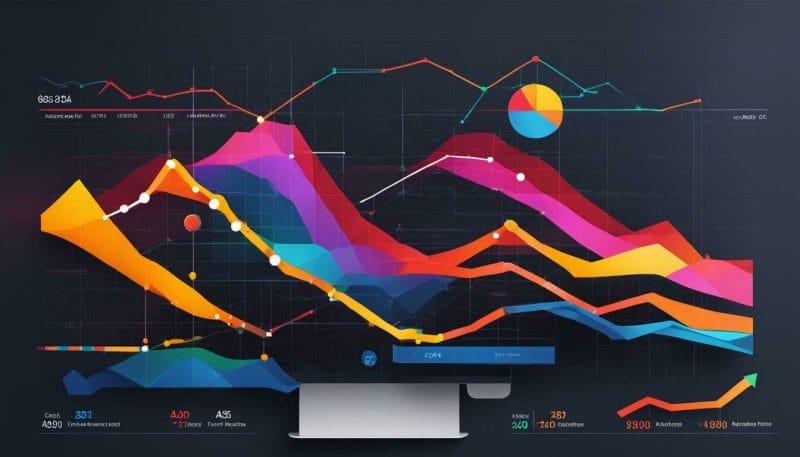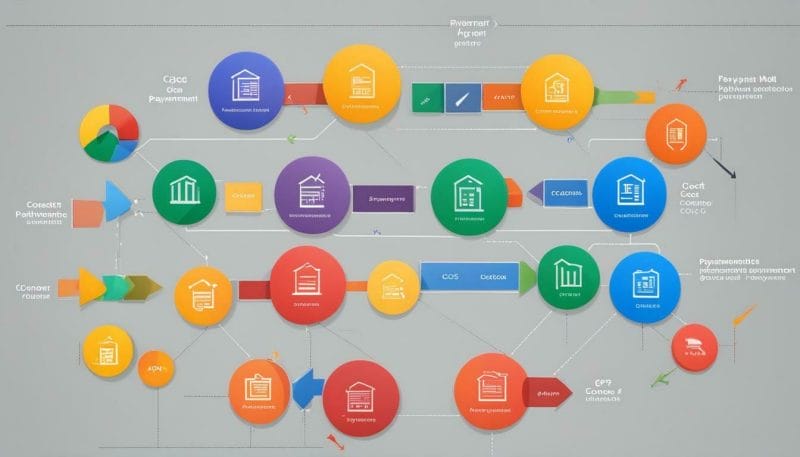Google Ads is an incredibly powerful platform that allows businesses to advertise their products or services online. It provides businesses with the opportunity to reach potential customers wherever they are on the web, making it a valuable tool for expanding their reach and driving growth in the Australian market. But you might be wondering “how does Google Ads work?”
With Google Ads, businesses can target specific audiences based on demographics, locations, and interests. This targeted advertising ensures that their ads are seen by the right people at the right time, maximising the effectiveness of their advertising budget. By leveraging the data and analytics provided by Google Ads, businesses can track the performance of their ads and make data-driven decisions to optimise their advertising strategies.
Google Ads offers flexibility in choosing payment models, such as cost-per-click or cost-per-impression pricing, allowing businesses to align their advertising goals with their budget. Additionally, the integration of Google Ads with Google My Business enables local businesses to showcase their offerings on Google Maps and in local search results, enhancing their visibility and attracting more customers.
With its wide reach across various websites and platforms, Google Ads has the potential to be seen by millions of people, increasing the chances of reaching the target audience. However, navigating the complexities of Google Ads and maximising its potential requires expertise and knowledge. That’s where Loudachris Digital Marketing can help.
Key Takeaways:
- Google Ads is a powerful platform for businesses to advertise their products or services online.
- It allows businesses to target specific audiences based on demographics, locations, and interests.
- Google Ads provides data and analytics to track the performance of ads and make informed decisions.
- Businesses have flexibility in choosing payment models that suit their goals.
- Google Ads integrates with Google My Business, enhancing the visibility of local businesses.
Targeting Audiences with Google Ads
One of the biggest advantages of Google Ads is its ability to target specific audiences with precision. This targeted advertising allows businesses to reach the right people at the right time, maximising their chances of generating leads and conversions. By leveraging data on demographics, locations, and interests, businesses can tailor their ads to resonate with their target audience.

For example, let’s say you own a boutique clothing store in Sydney. With Google Ads, you can target your ads specifically to users in the Sydney area who have shown an interest in fashion and shopping. This means that your ads will be displayed to potential customers who are more likely to be interested in your offerings, increasing the likelihood of them clicking on your ad and making a purchase.
Google Ads also allows for advanced audience targeting options. You can create custom audiences based on factors such as website visitors, app users, or customer lists. This level of granularity enables you to reach out to users who have already shown an interest in your business or are more likely to convert.
With the help of Loudachris Digital Marketing, we can help you explore the full range of audience targeting options available in Google Ads. Our team of experts will work closely with you to understand your business goals and develop a tailored strategy to reach your target audience effectively. By leveraging the power of audience targeting in Google Ads, you can maximise your advertising budget and drive meaningful results for your business.
Managing Your Advertising Budget on Google Ads
Google Ads empowers businesses to have full control over their advertising budget. With its flexible budgeting options, businesses can choose to set a daily or monthly budget, ensuring that they never spend more than they can afford. This level of control allows businesses to optimise their ad spend and maximise their return on investment.
One of the key features of Google Ads budgeting is the ability to adjust bids based on performance. By monitoring the performance of their ads, businesses can identify keywords or placements that are generating the most conversions and allocate more of their budget to those areas. Conversely, if certain keywords or placements are not performing well, businesses can reduce their bids to save budget and focus on more profitable areas.
In addition to bid adjustments, businesses can also set specific budget caps for campaigns or ad groups. This allows them to closely monitor their spending in different areas and ensure that the budget is allocated strategically. Google Ads provides real-time data and analytics to help businesses track their ad spend and measure the success of their campaigns. This data-driven approach enables businesses to make informed decisions about their advertising budget allocation.
To illustrate the effectiveness of budget management on Google Ads, consider the following example:
| Advertising Channel | Clicks | Conversion Rate | Cost per Conversion | Return on Investment (ROI) |
|---|---|---|---|---|
| Google Ads | 500 | 10% | $50 | 200% |
| Facebook Ads | 500 | 5% | $100 | 100% |
In this example, Google Ads has a higher conversion rate, a lower cost per conversion, and a higher return on investment compared to Facebook Ads. By carefully managing their advertising budget on Google Ads, businesses can achieve better results and make their ad spend go further.

With its powerful budgeting features, Google Ads provides businesses with the tools they need to optimise their ad spend and achieve their advertising goals. By monitoring performance, adjusting bids, and setting budget caps, businesses can ensure that every dollar spent on advertising delivers the maximum impact.
Bidding and Optimisation in Google Ads
Bidding and optimisation are crucial aspects of running successful campaigns on Google Ads. As an advertiser, it’s important to understand how to effectively bid on keywords and optimise your ads to achieve the best possible results. Loudachris Digital Marketing can help you navigate these complexities and maximise your return on investment.
When it comes to bidding, Google Ads offers different strategies to suit your advertising goals. You can choose from manual bidding, where you set the maximum amount you’re willing to pay for a click or conversion, or automated bidding, where Google’s algorithms optimise your bids based on your desired outcomes.
Optimization plays a key role in ensuring your ads perform well. It involves continuously refining your keywords, ad copy, and landing pages to improve ad relevance and user experience. By conducting thorough keyword research, identifying negative keywords, and testing different ad variations, you can enhance your ad performance and increase conversions.
Optimizing Your Ads with Ad Formats
Google Ads offers various ad formats to help you engage your target audience effectively. These include responsive search ads, which automatically adapt to fit different ad spaces; expanded text ads, which provide more space for your messaging; and image ads, which combine compelling visuals with relevant text. By utilising the right ad formats, you can capture the attention of potential customers and drive them to take action.
| Bidding Strategies | Key Features |
|---|---|
| Manual Bidding | – Full control over bids – Set maximum bid amounts – Adjust bids based on performance |
| Automated Bidding | – Google’s algorithms optimise bids – Target CPA, ROAS, or conversion value – Real-time adjustments for better results |
| Optimization Techniques | – Thorough keyword research – Negative keyword identification – Testing ad variations – Landing page optimisation |

By leveraging the expertise of Loudachris Digital Marketing, you can unlock the full potential of Google Ads bidding and optimisation. Our team of specialists understands the intricacies of the platform and stays up to date with the latest industry trends. We will work closely with you to develop tailored bidding strategies, optimise your ads, and continuously monitor performance to ensure you achieve your advertising goals.
Tracking Performance with Google Ads Analytics
Google Ads offers a range of powerful features to help businesses track and analyze the performance of their ads. With access to comprehensive data and analytics, businesses can gain valuable insights into the effectiveness of their campaigns and make data-driven decisions to optimise their advertising strategies.
One of the key features of Google Ads Analytics is the ability to track important metrics such as impressions, clicks, conversions, and click-through rates. These metrics allow businesses to measure the success of their ads and identify areas for improvement. With this data, businesses can refine their targeting, ad copy, and bidding strategies to drive better results.
Furthermore, Google Ads Analytics provides detailed demographic information about the audience that interacts with the ads. This data enables businesses to better understand their customers and tailor their marketing efforts to specific demographics, locations, and interests. By leveraging this information, businesses can create more targeted and relevant ads that resonate with their target audience.
| Key Metrics | Description |
|---|---|
| Impressions | The number of times your ads were shown to users |
| Clicks | The number of times users clicked on your ads |
| Conversions | The number of times users completed a desired action on your website |
| Click-through Rate (CTR) | The percentage of impressions that resulted in a click |
By analyzing these metrics, businesses can identify which ads are performing well and which ones need optimisation. They can also pinpoint the most effective keywords, ad placements, and targeting options for their campaigns. Armed with this knowledge, businesses can allocate their advertising budget more efficiently and maximise their return on investment.
Google Ads Analytics also offers visualization tools that make it easy to understand and interpret the data. Through charts, graphs, and tables, businesses can visualize trends, patterns, and correlations, enabling them to uncover valuable insights that can inform their advertising strategies.

Access to accurate and detailed analytics is crucial for businesses looking to optimise their Google Ads campaigns. By leveraging the powerful features of Google Ads Analytics, businesses can make data-driven decisions, refine their strategies, and achieve their advertising goals.
Payment Models in Google Ads
Google Ads provides businesses with flexible payment options to suit their specific needs. With this platform, businesses can choose from different payment models, such as cost-per-click (CPC) and cost-per-impression (CPM) pricing, allowing them to optimise their advertising budget.
CPC pricing means that businesses only pay when someone clicks on their ad. This model is beneficial as it ensures that businesses are only charged when there is genuine interaction with their ads. It also allows businesses to set a maximum bid, ensuring that they remain in control of their budget.
On the other hand, CPM pricing charges businesses per 1,000 ad impressions, regardless of whether or not users click on the ads. This model is suitable for businesses interested in increasing brand visibility and reaching a wide audience. It can be particularly effective when businesses have engaging and eye-catching ads that capture users’ attention.

When deciding on a payment model, it’s important for businesses to consider their advertising goals, target audience, and budget. It’s recommended to test different payment models to understand which one delivers the best results for the business.
In conclusion, Google Ads offers businesses flexible payment options to effectively manage their advertising budget. Whether businesses choose CPC or CPM pricing, they have the opportunity to reach their target audience and maximise their return on investment. By working with experienced digital marketing professionals like us at Loudachris Digital Marketing, businesses can optimise their payment model selection, implement effective ad strategies, and achieve their advertising goals.
Payment Models in Google Ads Table
| Payment Model | Description |
|---|---|
| Cost-Per-Click (CPC) | Businesses pay when someone clicks on their ad |
| Cost-Per-Impression (CPM) | Businesses pay per 1,000 ad impressions, regardless of clicks |
Integrating Google Ads with Google My Business
Google Ads seamlessly integrates with Google My Business, enhancing the visibility of local businesses. By connecting your Google Ads account with Google My Business, you can showcase your offerings on Google Maps and in local search results, making it easier for potential customers to find you. This integration allows you to utilise location extensions in your ads, displaying your business address, contact information, and even customer reviews. It’s a powerful way to attract local customers and drive more foot traffic to your physical store.
With the integration of Google Ads and Google My Business, you can also take advantage of local inventory ads. These ads enable you to showcase your product inventory and availability to nearby customers, enticing them to visit your store and make a purchase. By providing real-time information about your products, such as availability and pricing, you can increase customer engagement and drive sales.
Furthermore, the integration of Google Ads and Google My Business offers valuable insights into how customers interact with your business. You can track key metrics like clicks, calls, and requests for directions, giving you a better understanding of the impact your ads have on driving customer actions. Armed with this data, you can refine your advertising strategies and optimise your campaigns to get the best possible results.

- Increased visibility in local search results
- Utilization of location extensions to display business information
- Opportunity to showcase product inventory through local inventory ads
- Enhanced customer engagement and foot traffic to physical stores
- Data-driven insights into customer interactions and actions
Table: Comparison of Ad Performance Metrics
| Metric | Definition |
|---|---|
| Clicks | The number of times users clicked on your ad |
| Calls | The number of phone calls generated by your ads |
| Requests for Directions | The number of times users requested directions to your business location |
Integrating Google Ads with Google My Business is a game-changer for local businesses. It not only boosts visibility but also opens up opportunities to engage with customers on a more personal level. By leveraging location extensions and local inventory ads, businesses can make a significant impact on their bottom line. The ability to track key performance metrics further enhances the effectiveness of advertising campaigns. It’s a win-win situation for businesses looking to expand their reach and connect with local customers.
Reaching a Wide Audience with Google Ads
Google Ads offers businesses an extensive reach to engage with a wide audience. With its powerful advertising platform, businesses can showcase their products or services to millions of people across various websites and platforms.
One of the key advantages of Google Ads is its ability to target specific audiences based on demographics, locations, and interests. By targeting the right audience, businesses can ensure that their ads are seen by the people who are most likely to be interested in their offerings.
Moreover, Google Ads integrates with Google My Business, enabling local businesses to display their information on Google Maps and in local search results. This integration allows businesses to attract customers who are looking for products or services in their area.
To illustrate the impact of a well-implemented Google Ads campaign, consider this statistic: improving ad strength can lead to a 12% increase in conversions on average. Advertisers can achieve this by adding more headlines and descriptions, utilising unique messaging, and incorporating relevant keywords.

By leveraging Google Ads’ features and partnering with experts like Loudachris Digital Marketing, businesses can maximise their ad reach and effectively engage with a wide audience. Through creative and performance-driven strategies, businesses can optimise their advertising budget, track ad performance, and make data-driven decisions to drive their marketing success.
Conclusion
Understanding how Google Ads works is crucial for businesses looking to succeed in the online advertising landscape. With its powerful targeting capabilities, data analytics, and flexible payment models, Google Ads offers tremendous opportunities for businesses to reach their target audience and maximise their advertising budget.
Through targeted advertising based on demographics, locations, and interests, businesses can ensure that their ads are seen by the right people at the right time. This not only increases the chances of conversions but also optimises the allocation of advertising budget for maximum return on investment.
Google Ads provides valuable data and analytics that allow businesses to track the performance of their ads and make informed decisions about their advertising strategies. By analyzing key performance indicators such as quality score and optimisation score, businesses can further optimise their ads for better results.
In addition, the integration of Google Ads with Google My Business enables local businesses to showcase their offerings on Google Maps and in local search results, reaching potential customers in their vicinity.
With its wide reach across various websites and platforms, Google Ads has the potential to expose businesses to millions of people, increasing the chances of connecting with their target audience. However, to truly maximise the benefits of Google Ads, businesses should seek guidance from experts like Loudachris Digital Marketing, who can implement best practices and strategies to improve ad strength and drive conversions.
Overall, by understanding how Google Ads works and leveraging its features effectively, businesses can unlock the full potential of online advertising and achieve their advertising goals.
How Can Google Ads Help My Florist Business and How Can Loudachris Digital Marketing Assist?
Google Ads for florists can significantly boost your business visibility online. With Loudachris Digital Marketing’s expertise, your florist business can effectively target potential customers and increase website traffic through strategic ad campaigns. Let us help you showcase your beautiful floral arrangements to a wider audience and grow your business.
FAQ
How does Google Ads work?
Google Ads is an online advertising platform that allows businesses to promote their products or services on various websites and platforms. Businesses create ads and choose specific keywords that are relevant to their offerings. When users search for these keywords on Google or visit websites that are part of the Google network, the ads are displayed. Businesses only pay when users interact with their ads, such as clicking on them.
How does Loudachris Digital Marketing help with Google Ads?
Loudachris Digital Marketing is a professional agency that specialises in digital marketing, including Google Ads. We have the expertise to help businesses understand and navigate the complexities of Google Ads. Our team can assist in creating effective ad campaigns, optimising targeting, and managing advertising budgets. We can also provide insights and recommendations based on data and analytics from Google Ads to improve performance and ROI.
How can Google Ads target specific audiences?
Google Ads allows businesses to target specific audiences based on demographics, locations, and interests. Advertisers can specify the age, gender, location, and even interests of the audience they want to reach. This targeting ensures that ads are shown to people who are more likely to be interested in the products or services being advertised, increasing the chances of converting them into customers.
How does Google Ads help manage advertising budgets?
Google Ads provides businesses with the flexibility to set their advertising budgets and control their spending. Advertisers can choose between different payment models, such as cost-per-click (CPC) or cost-per-impression (CPM), depending on their goals. Businesses can also set daily or monthly budget caps to ensure they do not exceed their desired spending limits. Google Ads also provides data and insights to help businesses optimise their ad campaigns and make informed decisions about budget allocation.
How can businesses track the performance of their ads in Google Ads?
Google Ads offers data and analytics to track the performance of ads. Businesses can monitor metrics such as impressions, clicks, click-through rates (CTR), and conversions. This data helps businesses understand how their ads are performing and make data-driven decisions to optimise their campaigns. Google Ads also provides an optimisation score that suggests improvements based on best practices, which can further enhance ad performance.
What are the payment models available in Google Ads?
Google Ads offers different payment models, including cost-per-click (CPC) and cost-per-impression (CPM). With CPC, businesses pay when someone clicks on their ad, while with CPM, businesses pay for every 1,000 impressions, regardless of clicks. The choice of payment model depends on the advertising goals and budget allocation strategy of the business.
How does Google Ads integrate with Google My Business?
Google Ads can be integrated with Google My Business, a platform that allows businesses to manage their online presence on Google. By integrating the two, local businesses can showcase their offerings on Google Maps and in local search results. This integration helps businesses reach potential customers who are looking for products or services in their specific area.
How wide is the reach of Google Ads?
Google Ads has a wide reach across various websites and platforms. It can be seen by millions of people who use Google to search for information or visit websites that are part of the Google network. This broad reach increases the chances of businesses reaching their target audience and driving relevant traffic to their websites or brick-and-mortar locations.
What are the main takeaways from this article?
In summary, Google Ads is a powerful platform for businesses to advertise their products or services online. It offers targeting options, flexibility in payment models, data and analytics for performance tracking, and integration with Google My Business. Loudachris Digital Marketing can assist businesses in navigating Google Ads and improving their ad campaigns. Seeking guidance from experienced professionals can lead to better ad performance and greater ROI.
Book your FREE Google Ads Audit Today.

Chris Lourenco is the director of Loudachris Digital Marketing, an Adelaide-based SEO, Google Ads, and web design agency. Chris excels in crafting bespoke, results-driven strategies that help businesses get more traffic, leads and sales.



